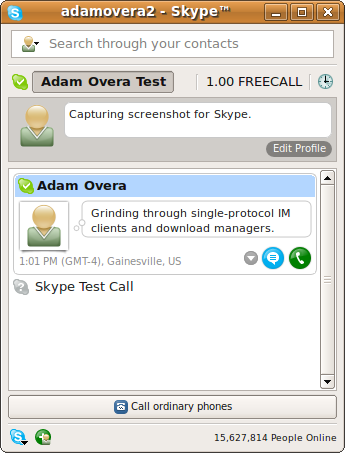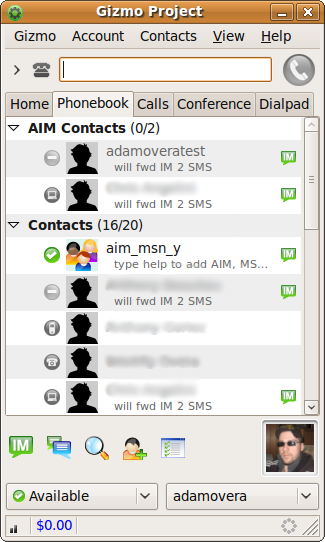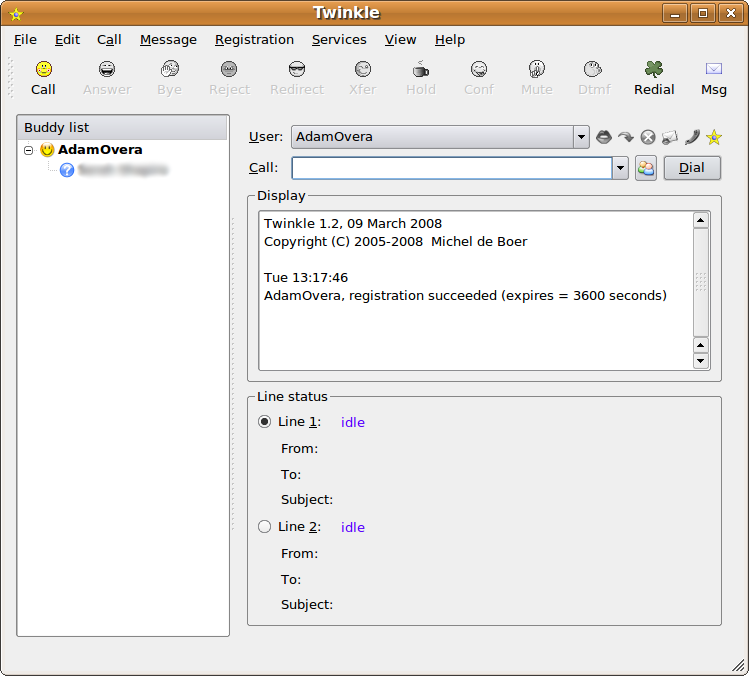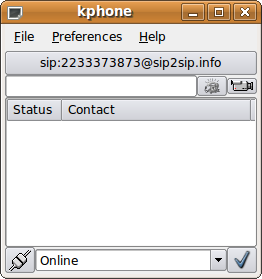Tom's Definitive Linux Software Roundup: Communications Apps
VoIP
In the past few years, Voice over Internet Protocol (VoIP) has been catching up to IM as a popular means of free PC-to-PC communication. Now that pretty much everyone is accessing the Internet via a broadband connection, it's no wonder that people are increasingly ditching text-based communication for real-time voice conversations.
More recently, some services have gone retail with the option for seriously cheap calling to traditional land line and mobile numbers. The downside is that 'open' VoIP is still very much a technical nightmare. The user configuration is archaic--much more so than email. Throw in even a simple home wireless network and you just might spend the afternoon on the phone with tech support. I doubt Tom's Hardware readers will have too much trouble setting up the 'open' softphones, but for Granny, it isn't happening. Hence the absolutely surreal popularity of Skype.
Skype (v. 2.0)
What can be said about Skype that hasn't already been said? From handling phone-a-friend on 'Who Wants to be a Millionaire' to patching through callers on Leo Laporte's radio show, at this point, Skype is a household name.
If you haven't at least heard of Skype, than you probably aren't reading this article, either. While FOSS fanatics will no doubt lose their marbles because of Skype's placement on this list, it deserves to be here, despite being a completely closed proprietary system. Due to it's unrivaled popularity as a VoIP protocol/client, there is no escaping the need for this application, unless of course you want to limit who you can communicate with.
Unfortunately, Skype's Linux client does not yet support video. In the interest of full disclosure, Skype is the preferred voice communication and IM method for us here at BestofMedia. After all, we're a global company and Skype is significantly cheaper than the telephone.
Gizmo Project (v. 3.1.0 build 79)
Get Tom's Hardware's best news and in-depth reviews, straight to your inbox.
Gizmo Project is first and foremost a VoIP application. But like Skype, it also handles IM. Gizmo works with any SIP or H.323 VoIP protocols, as well as AIM, MSN, Yahoo, Jabber, and GoogleTalk IM protocols.
What makes Gizmo stand out from the crowd is its ability to make and receive calls to regular land-line or mobile phone numbers completely free of charge when paired up with GoogleVoice. Even though GoogleVoice is still in a closed beta, it will have to go public at some point. Anyone lucky enough to be invited to the closed beta has most certainly already set this up. Gizmo is also working on a way to make VoIP calls to Skype users, something no other client can currently do. Unfortunately, Gizmo doesn't really do a very good job of it. My tests of this feature were hit and miss at best. Gizmo creates an anonymous Skype user ID to contact people using the Skype network. Since most Skype users block incoming calls from anonymous users, this feature failed pretty much every time.
Another downside is that Gizmo is a real resource hog, and that's on a Linux machine. If they could get the Skype compatibility down when paired with GoogleVoice, Gizmo would be the closest thing to a perfect communications app. Resource gluttony aside, Gizmo would replace VoIP, IM, Skype, phone, and voicemail. If you have an invitation to GoogleVoice, this is a must-have, nay, a killer app. Otherwise, it's still a good multi-protocol VOIP/IM client; but you're still going to need Skype...for now.
Twinkle (v. 1.2)
Twinkle's amateurish Web site belies what is the best 'open' protocol VoIP-only app for Linux.
Twinkle has a high degree of user-friendliness relative to other SIP/H.323 clients. However it also has the most configuration options, making it the choice of most advanced users as well. If you're having a problem with whatever client came with your distro and don't want to spend the time looking at every available VoIP app, get Twinkle and save yourself some time. If Twinkle did video or popular IM protocols, it would be one spot higher on this list because it's also very lightweight in comparison to Gizmo.
Kphone (v. 4.2)
I know what you're thinking. “Kphone is the VoIP client for KDE, right?” Wrong. KPhone has nothing to do with KDE. In fact, KDE does not yet have an integrated VoIP client. The development of KPhone is now done entirely by a community of volunteers. But don't let that deter you. I had no problems making and receiving calls with this lightweight client. Kphone has just enough options to allow even an intermediate user to troubleshoot problems with a little help from online forums. Unlike Ekiga, though, its interface isn't nearly as friendly. While it doesn't have the fully fleshed out feature set of Gizmo or Twinkle, it also doesn't leave as big of a footprint either, making Kphone a great option on older hardware.
Kphone does not have an option to minimize or close to the system tray, and to me, that's an annoyance in a VoIP client. Overall, Kphone is a great little communications app that also does video.
Ekiga (v. 3.2.0)
Ekiga is currently the default VoIP client for Ubuntu, but I have to seriously question why. One major failure with Ekiga is the lack of advanced setup and configuration options. When seeking help online, there are many (older) posts that reference options that are no longer part of the application. I'm all for simplification, but being inclined towards Linux (and before that, 3rd party apps), I also highly value options and the ability to customize.
The other major issue I had with Ekiga is not with the client, but its free SIP addresses. Getting the @ekiga.net addresses to register is a crap shoot from within the Ekiga client, and darn near impossible from any of the other SIP clients listed here. This is just one of those apps that will work out of the box for some, but will quickly become an unbearable pain for others. If you are fortunate enough to have a good experience with Ekiga, the simple IM-style interface and easy-to-setup webcam feature should be enough to keep your search for a good VoIP client extremely short.
-
mitch074 I'd like to add something to the article...Reply
- Skype for Linux is currently in version 2.1 (beta) which differs from 2.0 (final) only in the fact that it is now able to deal with ALSA, OSS and PulseAudio transparently - and it doesn't wreck webcam outputs as much.
- Skype for Linux has supported video ever since version 2.0 (beta); it does work quite well if your webcam sends uncompressed video to the system (if your webcam streams MJPEG and you have a 2.6.28+ kernel, you will need some hacker-fu; details on demand)
- a quite well known single protocol IM is aMSN, which is also multiplatform; its other main advantage is that it supports voice and video chats. However, it's not always very stable and requires manual setting up of a TCP port for video and voice to work properly. -
How about benchmarking the applications. Which ones use more ram vs. functionality? How about responsiveness and stability? Those are questions I would like to see laid out because much of the Linux user base have older hardware and don't like things eating away their CPUs and ram.Reply
-
oralward You should really cover something with kde desktop as only because of protest by gnome users is it still the default desktop in any of the three versions you are covering. Its also easier for someone coming from windows. There is a version of ubuntu called Kubuntu that uses kde. This is the other main desktop.Reply -
Great article.Reply
As far as KDE vs. Gnome, I see no problem with the current format, maybe just do a Ubuntu(Gnome) vs. Kubuntu(KDE) vs. Xubuntu(Xfce) vs. MoonOS/OpenGEU/JAD(Enlightenment) roundup, to show off the different desktops(and the few apps that only work on a particular desktop). Any look good with the right theme and some Compiz/Beryl, but KDE and Enlightenment have an edge right out of the box. -
rrockman It's... "Surprising" that you didn't analyze Mercury, one of the most advanced multi-account IM apps.Reply -
haplo602 ah gui only options ... well have a look at CenterIM when you have time. It's a great little IM tool that runs in the terminal. This way I can get to my client everywhere with just a simple ssh client :-)Reply -
"The one major protocol that Empathy supports and Pidgin doesn't is the increaasingly-popular Jabber."Reply
This is just plain wrong. Pidgin has supported Jabber for a long time. It's called XMPP in the later versions which is the name of the protocol used by jabber clients -
rdawise Again, I praise Mr. Overa's coverage of Linux. I am looking forward to the Games section of Linux since I don't have much experience with native games.Reply -
jppayne2 "My major problem with Thunderbird is that it will continually ask for confirmation to ignore a security certificate every time it checks for new mail, by default, every ten minutes. Most of the other clients in this roundup give you the option to always accept or ignore."Reply
Actually, Thunderbird allows you to permanently accept the certificate, which will do what you want. Just pay attention when the confirmation dialog comes up, and select "Accept this certificate permanently". It's the first option (the default is the second option, which is to accept the certificate for the current session).


























